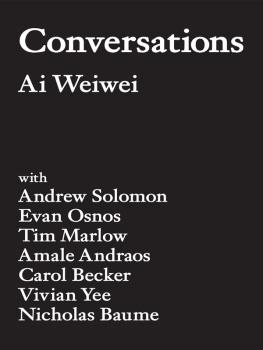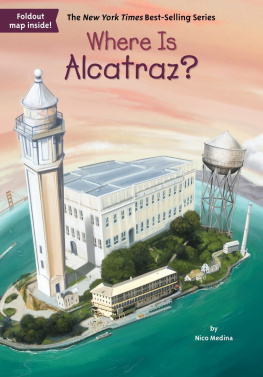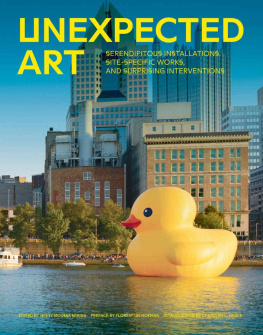

This book has been published on the occasion of the exhibition @Large: Ai Weiwei on Alcatraz, on view from September 27, 2014, to April 26, 2015.
The exhibition is presented by the FOR-SITE Foundation in partnership with the National Park Service and the Golden Gate National Parks Conservancy.

All rights reserved. No part of this book may be reproduced in any form without written permission from the publisher.
ISBN: 978-1-4521-4747-5 (epub, mobi)
Library of Congress Cataloging-in-Publication Data available.
Trade ISBN: 978-1-4521-4276-0 (hc)
FOR-SITE Foundation ISBN: 978-1-4521-4275-3
Editor: David Spalding
Designer: Public, San Francisco
Copy editor: Mark Chambers
Research: Tyler Reed
The opinions expressed in this book are the writers own and not necessarily those of the National Park Service or the Golden Gate National Parks Conservancy.
Copyright 2014 by the FOR-SITE Foundation.
FOR-SITE Foundation
49 Geary Street, Suite 205
San Francisco, CA 94108
www.for-site.org
Chronicle Books LLC
680 Second Street
San Francisco, California 94107
www.chroniclebooks.com/custom

Contents
Frank Dean and Greg Moore
Cheryl Haines
Ai Weiwei
Maya Kvskaya
Hans Ulrich Obrist
Philip Grosser
Martin Luther King Jr.
Mario Savio
Adam Fortunate Eagle / Indians of All Tribes
Al Silbowitz
Vclav Havel
Preface
Frank Dean and Greg Moore
The first Ai Weiwei piece to appear in the Golden Gate National Parks was installed as part of Presidio Habitatsa yearlong art exhibition (May 2010May 2011) organized by the FOR-SITE Foundation showcasing the work of artists and designers who conceived of homes for their animal clients. Ais projectfor Western screech owlsconsisted of classical blue-and-white porcelain forms evoking Chinese garden stools, each with an aperture to admit the feathered tenants. Hung from Presidio trees, the elegant ornamental vessels were a stark contrast to the rough, rustic backdrop of bark and coniferous boughs.

Ai Weiwei, Trace, 2014 (detail); installation: LEGO plastic bricks; part of @Large: Ai Weiwei on Alcatraz, Alcatraz Island, 20142015
At first blush, @Large: Ai Weiwei on Alcatraz, a major exhibition that pairs a politically charged Chinese contemporary artist with a landmark American national park, seems just as incongruous. Ai, a superstar in the international art world who helped design the Birds Nest stadium for the 2008 Beijing Olympics, is currently forbidden by the authorities to leave China. Alcatrazover the years the site of a Civil Warera fortress, a military prison, a notorious federal penitentiary, and a momentous Native American rights protestis now a popular national park site and refuge for waterbirds. But it is exactly the pairings intrinsic conditions of contradiction that bring the two parts togetherand make for the possibility of soul-stirring art.

Ai Weiwei, Western Screech Owl Habitats, 2010 (detail); part of Presidio Habitats, San Francisco, 20102011
Here in the Golden Gate National Parks, we have already seen memorable examples of such creative expression in a naturally rich and evocative setting. The aforementioned Presidio Habitatsa partnership between the Presidio Trust and the FOR-SITE Foundationwas one of the first major attempts to bring groundbreaking art to our parks. FOR-SITE, instrumental in bringing Andy Goldsworthys art to the Presidio, also partnered with the Golden Gate National Parks Conservancy and the National Park Service (NPS) on International Orange, an exhibition at Fort Point of site-specific installations responding to the Golden Gate Bridge and celebrating the spans seventy-fifth anniversary. Fort Point, a National Historic Site, was also transformed into a stage for immersive theater in 2008 and 2013, when the company We Players presented an innovative Macbeth amid the fortresss brick columns, arches, and ramparts.
These artistic endeavorsalong with Jeannene Przyblyskis multimedia tours of the Presidio and Lands End, and the yearlong Mark di Suvero at Crissy Field exhibition in partnership with the San Francisco Museum of Modern Artall stand as early successes for our nascent Art in the Parks program. This collaboration of the NPS, Parks Conservancy, and Presidio Trust, alongside community arts organizations such as the FOR-SITE Foundation, encourages both emerging and established artists to create place-based artworks that illuminate the natural and historic resources of the national park in fresh and compelling ways.
Art has always been integral to the genesisand successof Americas national parks. From the Hudson River painters to Ansel Adams and Chiura Obata, artists have produced works that helped romanticize, popularize, and ultimately protect the majestic landscapes that would become our national parks. Their legacy lives on today in the more than fifty artist-in-residence programs at parks across the NPS system (at Golden Gate, the program is offered by the nonprofit Headlands Center for the Arts).
While much of the art produced in these programs extols the abundant beauty of nature, @Largeour most recent Art in the Parks endeavorinvites visitors to examine some of the more provocative and harder edges of society: the implications of incarceration and the possibilities of creative expression as an act of conscience. Alcatraz, of course, was home to an infamous federal prison that counted among its inmates Al Capone, Machine Gun Kelly, Robert The Birdman Stroud, and other criminals who have achieved quasi-celebrity status. And Ai, although renowned in the art community and recognized among human rights activists for his civil disobedience, was imprisoned in 2011 for purported crimes.
Ais personal experiences while detained by the Chinese government underpin @Large: Ai Weiwei on Alcatraz, the first art exhibition of its caliber and scale to be presented on the famed island. Developed specifically for the old buildings of the federal prison, Ais art bolsters and supplements the interpretive story of this challenging, multilayered national park siteconfinement and liberty, repression and release, despair and hopeand the role and responsibility of the individual to drive social change. To these fundamental themes, @Large lends additional depth and dimension, exploring the cost of, and right to, individual and creative freedoms, and the uses of art and incarceration in acts of political defiance and assertion.
Indeed, @Large presents an opportunity to shine a light on darker aspects of Alcatrazs complex history and share lesser-known sides of Alcatraz with the more than 500,000 people expected to see the exhibition. For example, during the military prison epoch of the island (18571933), a variety of political prisoners were held on Alcatraz, including communists, anarchists, conscientious objectors to World War I (e.g., Quakers and Hutterites), and Hopi Indians who refused to send their children to government boarding schools.
Next page











